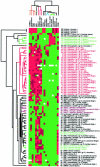Tissue microarray validation of epidermal growth factor receptor and SALL2 in synovial sarcoma with comparison to tumors of similar histology
- PMID: 14507652
- PMCID: PMC1868308
- DOI: 10.1016/S0002-9440(10)63502-X
Tissue microarray validation of epidermal growth factor receptor and SALL2 in synovial sarcoma with comparison to tumors of similar histology
Abstract
Histological diagnosis of synovial sarcoma can be difficult. Genome-wide expression profiling has identified a number of genes expressed at higher levels in synovial sarcoma than in other soft tissue tumors, representing excellent candidates for diagnostic immunohistochemical markers. A tissue microarray comprising 77 sarcomas, including 46 synovial sarcomas, was constructed to validate identified markers and investigate their expression in tumors in the differential diagnosis of synovial sarcoma. Immunostaining was performed for two such markers, epidermal growth factor receptor and SAL (drosophila)-like 2 (SALL2), and for fifteen established markers used in the differential diagnosis of sarcomas. As predicted by expression profiling, epidermal growth factor receptor (a potential therapeutic target) and SALL2 stained most cases of synovial sarcoma; staining was significantly less common among other tested sarcomas. Hierarchical clustering analysis applied to immunostaining results for all 18 antibodies showed that synovial sarcomas, leiomyosarcomas, hemangiopericytomas, and solitary fibrous tumors cluster distinctly, and assigned one case with indeterminate histology as a Ewing sarcoma. Digital images from over 2500 immunostained cores analyzed in this study were captured and are made accessible through the accompanying website: http://microarray-pubs.stanford.edu/tma_portal/synsarc.
Figures


Similar articles
-
Tissue microarray profiling of primary and xenotransplanted synovial sarcomas demonstrates the immunophenotypic similarities existing between SYT-SSX fusion gene confirmed, biphasic, and monophasic fibrous variants.Virchows Arch. 2006 Oct;449(4):435-47. doi: 10.1007/s00428-006-0271-9. Epub 2006 Sep 7. Virchows Arch. 2006. PMID: 16957934
-
Expression of receptor tyrosine kinases epidermal growth factor receptor and HER-2/neu in synovial sarcoma.Cancer. 2005 Feb 15;103(4):830-8. doi: 10.1002/cncr.20847. Cancer. 2005. PMID: 15641030
-
TLE1 as a diagnostic immunohistochemical marker for synovial sarcoma emerging from gene expression profiling studies.Am J Surg Pathol. 2007 Feb;31(2):240-6. doi: 10.1097/01.pas.0000213330.71745.39. Am J Surg Pathol. 2007. PMID: 17255769
-
Expression profiling in soft tissue sarcomas with emphasis on synovial sarcoma, gastrointestinal stromal tumor, and leiomyosarcoma.Adv Anat Pathol. 2010 Sep;17(5):366-73. doi: 10.1097/PAP.0b013e3181ec7428. Adv Anat Pathol. 2010. PMID: 20733355 Review.
-
Chromosomes in the diagnosis of soft tissue tumors. I. Synovial sarcoma.Mod Pathol. 1992 Jul;5(4):357-62. Mod Pathol. 1992. PMID: 1379714 Review.
Cited by
-
Pitfalls in immunohistochemical assessment of EGFR expression in soft tissue sarcomas.J Clin Pathol. 2006 Jun;59(6):585-90. doi: 10.1136/jcp.2005.028373. Epub 2006 Feb 3. J Clin Pathol. 2006. PMID: 16461571 Free PMC article.
-
Low HIF-1α and low EGFR mRNA Expression Significantly Associate with Poor Survival in Soft Tissue Sarcoma Patients; the Proteins React Differently.Int J Mol Sci. 2018 Dec 3;19(12):3842. doi: 10.3390/ijms19123842. Int J Mol Sci. 2018. PMID: 30513863 Free PMC article.
-
Molecular profiling of childhood cancer: Biomarkers and novel therapies.BBA Clin. 2014 Jun 28;1:59-77. doi: 10.1016/j.bbacli.2014.06.003. eCollection 2014 Jun. BBA Clin. 2014. PMID: 26675306 Free PMC article. Review.
-
Visual Counting and Automated Image-analytic Assessment of Ki-67 and their Prognostic Value in Synovial Sarcoma.Cancer Diagn Progn. 2022 Jan 3;2(1):7-14. doi: 10.21873/cdp.10070. eCollection 2022 Jan-Feb. Cancer Diagn Progn. 2022. PMID: 35400010 Free PMC article.
-
Immunoprofiles of 11 biomarkers using tissue microarrays identify prognostic subgroups in colorectal cancer.Neoplasia. 2005 Aug;7(8):741-7. doi: 10.1593/neo.05178. Neoplasia. 2005. PMID: 16207476 Free PMC article.
References
-
- Machen SK, Easley KA, Goldblum JR: Synovial sarcoma of the extremities: a clinicopathologic study of 34 cases, including the semi-quantitative analysis of spindled, epithelial and poorly differentiated areas. Am J Surg Pathol 1999, 23:268-275 - PubMed
-
- van de Rijn M, Barr FG, Xiong QB, Hedges M, Shipley J, Fisher C: Poorly differentiated synovial sarcoma: an analysis of clinical, pathologic, and molecular genetic features. Am J Surg Pathol 1999, 23:106-112 - PubMed
-
- Folpe AL, Schmidt RA, Chapman D, Gown AM: Poorly differentiated synovial sarcoma: immunohistochemical distinction from primitive neuroectodermal tumors and high-grade malignant peripheral nerve sheath neoplasms. Am J Surg Pathol 1999, 22:673-682 - PubMed
-
- Pollack JR, van de Rijn M, Botstein D: Challenges in developing a molecular characterization of cancer. Semin Oncol 2002, 29:280-285 - PubMed
Publication types
MeSH terms
Substances
Grants and funding
LinkOut - more resources
Full Text Sources
Other Literature Sources
Molecular Biology Databases
Research Materials

